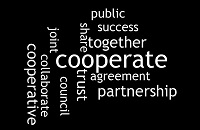 Subscribers Only
People
Subscribers Only
People 

Richard Sennett’s Together: the rituals, pleasures and politics of co-operation (2012) is one of those books that’s so full of acute observations, surprising examples and novel connections that it stays long in the memory and sparks all kinds of thoughts, months after an initial reading.
Together, the second of a trilogy on ‘the skills people need to sustain everyday life’, ranges over many types of co-operative behaviour, but there are some strange omissions, the most surprising being discussion of the worldwide co-operative movement. Another absentee is co-operation between organisations rather than individuals – a subject that I’ve always found absorbing, especially in the context of public services. I’ve just been reminded about its importance by the publication of the report of the Williams Committee on public service governance and delivery in Wales.
What’s caught the media’s attention in this report, naturally enough, is its recommendation to halve the number of local authorities in Wales, but in fact its remit is wide and covers the whole of public services (though its treatment of cultural public services is very sketchy indeed, and its only recommendation in the area has already been superseded).
The report devotes a lengthy and interesting section (2.87 – 2.128) to ‘collaboration and partnership working’ between public bodies. It recalls the emphasis that early Welsh governments, following the lead of the Government of Wales Act 1998, placed on collaboration as an alternative to two other ways of pursuing greater efficiency and improved services to the public: expensive restructuring of service providers, and competitive, market solutions of the kind favoured in England. The ‘Making the Connections’ programme (2004) urged organisations to share services and the resources available to provide them, and the Beecham Report, Beyond boundaries (2006) repeated the message, more urgently still.
These initiatives certainly resulted in activity, the most visible being the creation of Local Service Boards that brought together individual local authorities with other service providers in the region to investigate and carry out new ways of working in partnership. The Williams report fails to identify any good evaluation of the effectiveness of LSBs, but its conclusion, based on the evidence that exists, is that the results of their efforts are disappointing, as are outcomes for partnership working more generally. It’s proved hard to overcome the complexities of true co-operation and to reconcile partnership aims with the aims of individual participators, administering partnerships is a heavy burden, varying accountabilities are problematic, and there has been far more debate than action. Williams points to similarly poor outcomes in Scotland and comes to the conclusion that co-operation simply does not work as a national solution across Wales.
Williams proposes in section 2.106 a number of conditions that need to be fulfilled before there is a reasonable chance of inter-service collaboration bearing fruit. These include initial clarity about the shared aims of partnership and about accountabilities, and the need for commitment at the highest level in each partner. It also suggests reform of the existing LSBs.
The report quotes several recent cases of failed attempts to merge particular services across local authority boundaries and is harsh about the failure to merge generic ‘back office’ functions like procurement, legal services and human resource services across authorities: NHS experience shows that this is possible, and Williams, like a World War I general, advocates ‘do it again, try harder’.
The report quotes some bodies who blame failures on the Welsh Government, for failing to be explicit about how exactly bodies should collaborate, and on what, and treating collaboration as an end in itself rather than a means. Williams exonerates the Government on this charge, insisting that the bodies themselves should have answered the initial questions of what and how, but it does suggest that Government has not be consistent in its efforts to encourage co-operation, for example in its use of grants.
The report’s conclusion about the prospects for collaboration is bleak. The patchy record so far, high costs of co-operation and the lack of clarity about aims all suggest that, as one chief executive is quoted as saying, ‘If you do not legislate for [collaboration], it will not happen’.
And so the Assembly’s long love affair with voluntary partnership and collaboration is at an end.
Restructuring is the new answer, at least in the critical area of local government. All political parties seem agreed that there should be such a restructuring and even opponents seem half-hearted in their opposition so far, despite the fact that the costs will be large – far larger, I suspect, than Williams estimates – that service quality will inevitably drop, at least for some years, that the long-term savings may be fewer than hoped for, and that the scarcity and stress of ‘austerity’ offer the worst possible climate for massive, disruptive change.
In his book Richard Sennett identifies three types of co-operative behaviour: altruism, win-win and differentiating (acknowledging distinctiveness and difference in a dialogic exchange). The value of these categories is that they help show that ‘co-operation’ is not all of one sort: it covers numerous different kinds of relationship.
So what are the potentialities and the limits of co-operative endeavour between public services?
Here are some of my thoughts, based on twenty years and more of trying to lead and participate in collaborative activity shared by several public bodies: it’s a sort of alternative list to the rather limited one offered by the Williams report in section 2.106.
- First, and most important, the participants must themselves wish to work together seriously. They should desire to do so, rather than feel obliged to do so by others, including higher authorities like governments. I suspect that many of those responding to the Welsh Government’s ‘Making the Connections’ sermons did so reluctantly, like surly schoolchildren, investing little personal or institutional resource into the project.
- It helps enormously if you work in a context or profession that itself places a high value on co-operation as a natural or even preferred mode of doing business. I always counted myself lucky that librarians and information professionals, by inclination and training, tend to be naturally collaborative if not altruistic, in contrast to some other professions that value competition and welcome conflict.
- Trust is the most essential ingredient of successful collaboration. Often trust is best nurtured over a lengthy period of time. The most productive co-operative group I belonged to had existed for over twenty years; its members knew one another well and had learned to trust one another through a long history of interaction. The more trust exists, the more chance there is of extending the reach of Sennett’s win-win cooperation and even of exploring the possibilities of altruism. Trust is a personal characteristic, of course, but it’s capable of being transferred to an organisation.
- The further up Sennett’s spectrum you can afford to go the more you can achieve, and the less it matters that the relationship between partners is asymmetrical, with stronger members more capable of contributing but also more able to benefit. Though, as Sennett’s differentiating category show, it’s possible to operate a partnership successful at a lower co-operation level as long as all partners acknowledge their strengths and weaknesses, and the implications those strengths and weaknesses bring.
- As the Williams report says, it’s essential to be clear about what co-operation is intended to achieve, and why: to produce an improved service? to reduce partners’ costs? Next, what objectives or projects offer suitable material for collaboration? They may or may not be ambitious, but they should be practical, not involve costs that cancel out their value, and be acceptable to those to whom the partners are accountable.
- An analysis of possible fields of co-operation often concludes that collaborative action may work best not in sensitive areas of regular, ongoing core services, but in new developments: projects that seek to provide something innovative and of large public benefit.
If they have any validity these guidelines suggest two main conclusions.
First, a government can’t ‘command’ co-operation from other bodies. They, and especially those leading them, must have a genuine desire and interest in becoming partners with other organisations in a common enterprise. The organisation I belonged to responded to ‘Making the Connections’ in several ways, but more out of a spirit of compliance than of belief. We pursued our real co-operative projects because we had a strong desire to do so and a strong belief in their efficacy, and not because we were instructed. That isn’t to say that governments can’t do their best to instil and encourage co-operative cultures in the bodies they fund.
Therefore, as the Williams report concludes, government initiatives like ‘Making the Connections’ were never going to result in a coherent and effective system of cross-border collaboration that would replace the need to consider other ways of reducing costs and improving services. Had this been realised earlier local government might have been restructured years ago, at a much more suitable time than now.
Second, in the right circumstances co-operation between public services can work much more effectively than the Williams report appears to believe. It depends critically, though, on the presence of key cultural and leadership assets, the greatest of which is the ability to trust other people, and by extension other organisations. Trust is one of the three sides of Sennett’s ‘social triangle’ of what he calls the ‘old economy’. He quotes William James as saying that when we trust we are ready ‘to act in a cause the prosperous issue of which is not certified to us in advance’, and he himself likens trust to tools ‘you are willing to use even though you don’t quite know how they work’. Trusting others in co-operative endeavour can be a way not just of achieving what you can’t achieve alone, but of taking a step into the unknown, of nurturing innovation in a climate of uncertainty.
Andrew Green was Librarian of the National Library of Wales between 1998 and 2013.



Lots of pertinent points here – albeit of an understandably pessimistic cast.
I don’t think that the Assembly has fallen out of love with voluntary collaboration, but maybe a bit of marriage-guidance is needed to put the relationship back on track. Trust is absolutely at the heart of that.
Williams’ suggestion that the Government has been sending mixed messages regarding co-operation is certainly true – commissioning approaches seldom support genuine collaboration or the broader aspirations of social justice and equality which most public service organisations share. And it’s also true that government can’t legislate for collaboration, although legislation can act as a powerful stimulus for change.
In this regard the Report is explicit, and radical. Williams proposes:
‘a clearer shared vision and sense of common purpose between government at all
levels, citizens, and communities;
a much greater focus on co-production with citizens and communities to identify
and implement means of pursuing those outcomes;
a much stronger emphasis on enablement, empowerment and
prevention in the design and delivery of public services.’
The Report goes on to assert that:
‘This is the only way of sustaining viable and high-quality public services. No public sector system can continue to meet growing levels of demand for high-cost responsive services from declining real resources; the emphasis has to shift to reducing demand for such services through prevention and co-production. Even if those pressures did not exist, there would be a strong case in principle for making this kind of change and reconnecting government and public service more intimately with those that they serve.’
Co-production is a systematic and transformative approach to collaboration, between public sector professionals and the communities and citizens they serve. It is already happening right across Wales – in communities, schools, social care and health settings, housing associations etc – and evidence for its efficacy is growing rapidly. We are world leaders in time-banking – a highly effective model of co-production. The Health Minister has set up a Co-production Implementation Group, chaired by CMO Ruth Hussey, to help progress this agenda. The New Economics Foundation have offered to run a series of Co-production Commissioning Masterclasses in Wales to transform this aspect of service provision. And co-production will be written in to the regulations of the Social Services and Wellbeing Bill.
This combination of evidence, activism, training and legislation, backed by policy documents such as the Williams Report, could just provide sufficient mix of carrots and sticks to shift the donkey / restart the love affair.